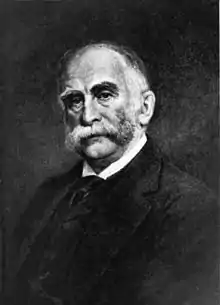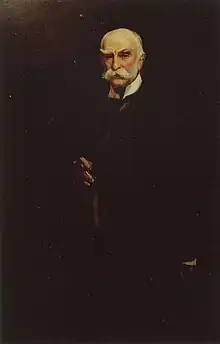James C. Carter
James Coolidge Carter (October 14, 1827 – February 14, 1905) was a New York City lawyer, a partner in the firm that eventually became Carter Ledyard & Milburn, which he helped found in 1854.
James C. Carter | |
|---|---|
 After an etching on copper plate by James S. King, copyrighted and published by Charles Barmore of New York. | |
| Born | October 14, 1827 Lancaster, Massachusetts, U.S. |
| Died | February 14, 1905 (aged 77) New York City, New York, U.S. |
| Nationality | American |
| Education | Derby Academy |
| Alma mater | Harvard College Harvard Law School |
| Occupation | Lawyer |
Early life
Carter was born on October 14, 1827, in Lancaster, Massachusetts. He was the youngest of eight children born to Maj. Solomon Carter.[1]
He prepared for college at Derby Academy in Hingham.[1] He graduated from Harvard College in 1850 and Harvard Law School in 1853.[2] While at Harvard, he was a member of the Institute of 1777 the Hasty Pudding Club, Alpha Delta Phi, and the Phi Beta Kappa Society.[1]
Career

Carter entered the law office of Edward Kent, son of Chancellor James Kent, in New York, and in 1853 was admitted to the bar, starting a prominent law practice which later became known as Carter Ledyard & Milburn.[1]
He was one of the founders and the first president of the National Civic League. In 1875, Governor Samuel J. Tilden appointed him a member of the commission to devise a form of municipal administration for cities in the state of New York, and in 1888, Governor David B. Hill appointed him a member of the Constitutional Commission. In 1892, he was appointed by President Benjamin Harrison as counsel, with Edward J. Phelps and Judge Henry Williams Blodgett, to present the claims of the United States before the Bering Sea tribunal.[3][4]
Political Mugwump
Carter was an influential legal theorist among fellow Mugwumps. He deeply distrusted politicians and most elected officials. Instead he put his trust in disinterested experts, especially judges. He equated common law with custom, and his condemnation of legislation inconsistent with custom, reflected his Mugwumpism. He tried to synthesize traditional thinking with modernity. For example, Carter clung to support for active government intervention he learned from the antebellum Whigs, but he more and more embrace antigovernment positions typical of antebellum Jacksonians. He tried to synthesize traditional faith in timeless, objective moral principles with a more modern vision of evolving customary norms. Given growing problems of industrial urban society he saw the need for positive government but wanted judges to rule not politicians.[5]
Personal life
After an illness of a few days,[1] he died at 7 East 88th Street (a Beaux-Arts townhouse built in 1903 by architects James R. Turner and William G. Killian),[6] his residence in New York City on February 14, 1905.[7][8][9][10][11][12][13] In New York, his funeral was held at All Souls' Church on Fourth Avenue and 22nd Street.[14] Another funeral was conducted by the Rev. Prof. Francis Greenwood Peabody of Harvard and was held at the Mount Auburn Chapel at Cambridge where he was buried.[15]
Legacy
In 1897, he donated $5,000 towards the construction of the Randolph Tucker Memorial Hall at Washington and Lee University, estimated at that time to cost $50,000.[16]
References
- "JAMES C. CARTER DIES AFTER BRIEF ILLNESS; Distinguished Member of New York Bar Succumbs at Home. HAD OVERTAXED STRENGTH His Long Career in the Practice of Law, and His Services for Municipal Reform". The New York Times. 15 February 1905. Retrieved 16 March 2023.
- Wilson, J. G.; Fiske, J., eds. (1900). . Appletons' Cyclopædia of American Biography. New York: D. Appleton.
- Gilman, D. C.; Peck, H. T.; Colby, F. M., eds. (1905). . New International Encyclopedia (1st ed.). New York: Dodd, Mead.
- Rines, George Edwin, ed. (1920). . Encyclopedia Americana.
- Lewis A. Grossman, "James Coolidge Carter and Mugwump Jurisprudence." Law and History Review 20.3 (2002): 577-629.
- Cohen, Michelle (October 12, 2017). "Options are many for this five-story $30M Beaux-Arts limestone townhouse on Museum Mile". 6sqft. Retrieved 16 March 2023.
- Hicks, Frederick Charles (1929). "Carter, James Coolidge". Dictionary of American Biography. New York: Charles Scribner's Sons.
- Schlup, Leonard C.; Ryan, James G. (2003). Historical Dictionary of the Gilded Age. M.E. Sharpe. p. 80. ISBN 0-7656-2106-1. Extract of page 80
- Miller, George Alfred (1909). "James Coolidge Carter. 1827-1905.". In W. D. Lewis (ed.). Great American Lawyers. Vol. VIII. pp. 1–41.
- "The City Club's New Home," New York Times (October 3, 1892).
- "Book of Members, 1780–2010: Chapter C" (PDF). American Academy of Arts and Sciences. Retrieved September 11, 2016.
- George W. Martin, Causes and Conflicts: The Centennial History of The Association of the Bar of the City of New York (1870-1970), Houghton-Mifflin Company, 1970.
- Association of the Bar of the City of New York, Reports 36, p. 41.
- "JAMES C. CARTER'S FUNERAL.; Bench and Bar Represented at the Service". The New York Times. 18 February 1905. Retrieved 16 March 2023.
- Times, Special to The New York (19 February 1905). "JAMES C. CARTER'S FUNERAL.; Services Conducted in Mount Auburn Chapel at Cambridge". The New York Times. Retrieved 16 March 2023.
- "GIFT FROM JAMES C. CARTER.; $5,000 to Help Erect a Building for Washington and Lee University". The New York Times. 29 June 1897. Retrieved 16 March 2023.
Further reading
- Grossman, Lewis A. "James Coolidge Carter and Mugwump Jurisprudence." Law and History Review 20.3 (2002): 577-629. online